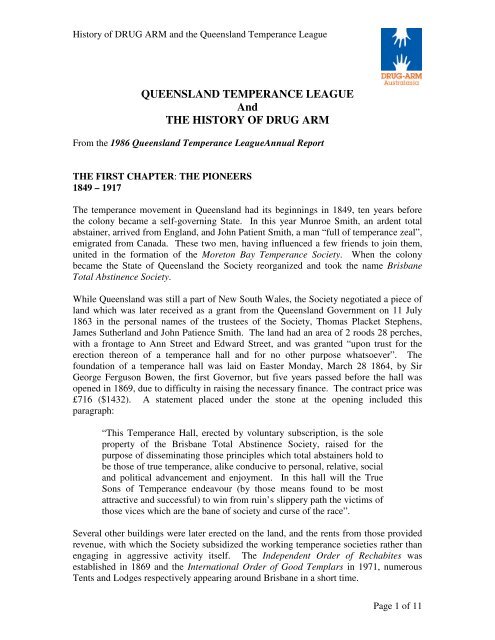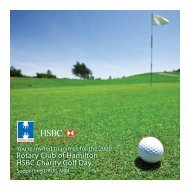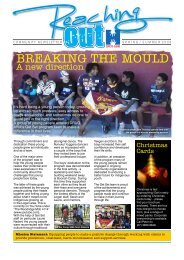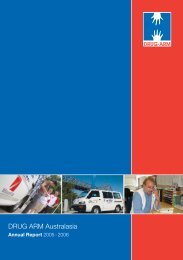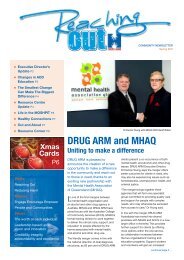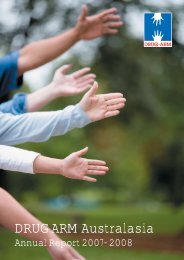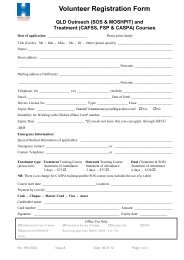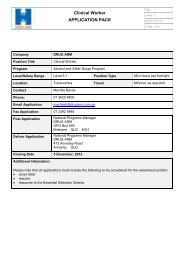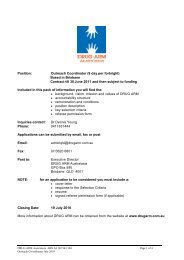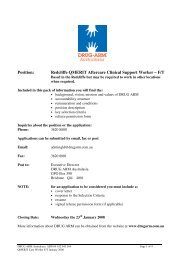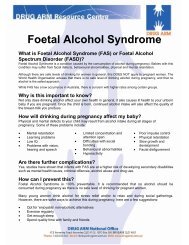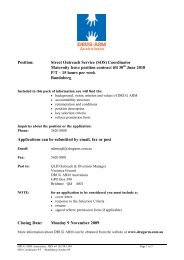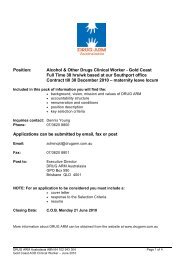QUEENSLAND TEMPERANCE LEAGUE And THE ... - Drug Arm
QUEENSLAND TEMPERANCE LEAGUE And THE ... - Drug Arm
QUEENSLAND TEMPERANCE LEAGUE And THE ... - Drug Arm
You also want an ePaper? Increase the reach of your titles
YUMPU automatically turns print PDFs into web optimized ePapers that Google loves.
History of DRUG ARM and the Queensland Temperance League<br />
<strong>QUEENSLAND</strong> <strong>TEMPERANCE</strong> <strong>LEAGUE</strong><br />
<strong>And</strong><br />
<strong>THE</strong> HISTORY OF DRUG ARM<br />
From the 1986 Queensland Temperance LeagueAnnual Report<br />
<strong>THE</strong> FIRST CHAPTER: <strong>THE</strong> PIONEERS<br />
1849 – 1917<br />
The temperance movement in Queensland had its beginnings in 1849, ten years before<br />
the colony became a self-governing State. In this year Munroe Smith, an ardent total<br />
abstainer, arrived from England, and John Patient Smith, a man “full of temperance zeal”,<br />
emigrated from Canada. These two men, having influenced a few friends to join them,<br />
united in the formation of the Moreton Bay Temperance Society. When the colony<br />
became the State of Queensland the Society reorganized and took the name Brisbane<br />
Total Abstinence Society.<br />
While Queensland was still a part of New South Wales, the Society negotiated a piece of<br />
land which was later received as a grant from the Queensland Government on 11 July<br />
1863 in the personal names of the trustees of the Society, Thomas Placket Stephens,<br />
James Sutherland and John Patience Smith. The land had an area of 2 roods 28 perches,<br />
with a frontage to Ann Street and Edward Street, and was granted “upon trust for the<br />
erection thereon of a temperance hall and for no other purpose whatsoever”. The<br />
foundation of a temperance hall was laid on Easter Monday, March 28 1864, by Sir<br />
George Ferguson Bowen, the first Governor, but five years passed before the hall was<br />
opened in 1869, due to difficulty in raising the necessary finance. The contract price was<br />
£716 ($1432). A statement placed under the stone at the opening included this<br />
paragraph:<br />
“This Temperance Hall, erected by voluntary subscription, is the sole<br />
property of the Brisbane Total Abstinence Society, raised for the<br />
purpose of disseminating those principles which total abstainers hold to<br />
be those of true temperance, alike conducive to personal, relative, social<br />
and political advancement and enjoyment. In this hall will the True<br />
Sons of Temperance endeavour (by those means found to be most<br />
attractive and successful) to win from ruin’s slippery path the victims of<br />
those vices which are the bane of society and curse of the race”.<br />
Several other buildings were later erected on the land, and the rents from those provided<br />
revenue, with which the Society subsidized the working temperance societies rather than<br />
engaging in aggressive activity itself. The Independent Order of Rechabites was<br />
established in 1869 and the International Order of Good Templars in 1971, numerous<br />
Tents and Lodges respectively appearing around Brisbane in a short time.<br />
Page 1 of 11
History of DRUG ARM and the Queensland Temperance League<br />
The Society was managed by a committee called the Temperance Council which<br />
consisted of representatives elected by temperance organizations whose places of meeting<br />
were within a radius of three miles of the General Post Office. As the settlement grew<br />
this was extended to five miles, then ten and again to twelve miles.<br />
The Woman’s Christian Temperance Union was established in 1885 as a result of a visit<br />
of Mrs Mary Clement Leavitt from America with the active support of the Brisbane Total<br />
Abstinence Society. Unions were quickly established in every town of any size, and at<br />
the time of the first State Convention in 1886 there were 239 active and 42 honorary<br />
members. The Union’s headquarters were initially in the Temperance Hall, but its own<br />
property, Willard House, was subsequently acquitted. This body was not represented on<br />
the Temperance Council because its low membership fees did not satisfy the<br />
Constitutional requirements of the Council.<br />
In 1887 a portion of the Society’s land was resumed for the proposed railway, and an<br />
alternative piece of land was bought in Turbot Street between George and Roma Streets.<br />
The Government passed legislation freeing the Ann Street land from the trust and<br />
requiring the proceeds of its sale to be used for the erection of a new temperance hall on<br />
the new site, as well as “suitable buildings in connection therewith”. As it happened, the<br />
recession of the 1890’s made it difficult to sell the old property and the flood of 1893<br />
made the Turbot Street property less attractive, so that the move did not proceed. The<br />
latter property was eventually sold after involving the Society in financial loss over a<br />
number of years and seriously impairing its ability to carry out its task.<br />
Meanwhile, an additional body called The Queensland Temperance Alliance was<br />
inaugurated on 26 June 1896 under the presidency of Rev. A.C. Jarvis. It was formed as<br />
a means of unifying the various temperance agencies, and its executive committee<br />
consisted as far as possible of representatives of the various churches, the Good<br />
Templars, Rechabites, and the W.C.T.U. Its objective was to form a working body in<br />
every electorate. It undertook all temperance work and organized many of the polls<br />
under local option, and issued a monthly paper, the Alliance News.<br />
<strong>THE</strong> SECOND CHAPTER: <strong>THE</strong> SEASON OF PROHIBITION<br />
1919 to 1926<br />
A new Australian organization was formed in Melbourne in 1918 known as the Strength<br />
of Empire Movement. Its stated purpose was “combating drink and venereal disease”,<br />
two evils brought into stronger relief by the war conditions. At the request of the<br />
Movement’s Victorian president, the federal organizer, Mr W. Greenfield, visited<br />
Brisbane in July of that year and met a number of public men at a special dinner. The<br />
following afternoon a meeting was held in the temperance hall when the Queensland<br />
body was formed with Sir David Hardie, M.D. as president.<br />
Page 2 of 11
History of DRUG ARM and the Queensland Temperance League<br />
Mr Arthur Toombes, then the federal organizer for the Australian Temperance Alliance<br />
and based in Melbourne, accepted an invitation to be State Superintendent, which he took<br />
up on 12 November 1918. Born in Rockhampton in 1884 he became interested in the<br />
temperance movement at the age of seventeen and was exclusively engaged in the work<br />
from the age of 23, holding positions in Queensland organizations, the Newcastle<br />
division of the N.S.W. Alliance, and again in Queensland as State organizer for the Good<br />
Templars, afterwards being responsible for major campaigns in Queensland, New South<br />
Wales and New Zealand before his Melbourne appointment.<br />
The first task which faced the new movement was the consolidation of the various<br />
denominational factions in the Commonwealth, whose differences at times threatened to<br />
seriously weaken the entire undertaking. It was hoped that the new movement, having no<br />
party-political attachment, might bring together the factions, and in uniting the moral<br />
forces give a new and added impetus to the cause. The temperance societies were in fact<br />
brought together into a solid, united and enthusiastic force, and there was a “splendid<br />
accession of new strength such as no moral reform organization has been previously<br />
favoured with in this State”.<br />
The first to agree to the proposed plan of consolidation were the several Protestant<br />
churches, the Anglican Church being quickly brought into line through the outspoken<br />
support of Archbishop Donaldson, a vice-president of the movement. The Queensland<br />
Temperance Alliance early decided on the fullest cooperation but subsequently the<br />
weakness was obvious of having two societies so similar in objective and making<br />
demands on the same people, and so the two Executives unanimously decided to merge,<br />
and this was ratified by the General Meetings.<br />
After further negotiation the various temperance bodies also gave wholehearted support<br />
and separately consented to the merger which was completed before the end of the year.<br />
The next thing was to utilize the combined strength of the organizations in a huge<br />
campaign for moral and temperance reform. A State Temperance Congress attended by<br />
representative of more than 300 societies aroused sustained interest, the press giving<br />
daily reports of the proceedings. A competent campaigning and canvassing staff of ten<br />
members, under the direction of Mr H.C. Moore, conducted a number of successful<br />
membership drives around the State, and Mr E.W. Chafin of America conducted a series<br />
of meetings in 1919. More than 60 branches were formed during the first year, and the<br />
Strength of Empire journal was published.<br />
The year 1920 saw a statewide campaign on the issue of prohibition with heavy financial<br />
responsibilities for the movement. A large staff of organizers was appointed and 10,000<br />
honorary workers were mobilized. An advertising campaign was conducted in almost<br />
every newspaper, the State was flooded with literature, and posters, signs, slides, etc.<br />
were supplied wherever they could be used. The results surprised the movement and<br />
astonished their opponents. The securing of a 45% vote for State prohibition at the first<br />
poll was totally unexpected, with majority verdicts in favour in Brisbane and every large<br />
Page 3 of 11
History of DRUG ARM and the Queensland Temperance League<br />
town in southern Queensland. With all this activity and enthusiasm the movement<br />
became concerned that it was using an office that added nothing to its prestige nor aided<br />
its campaign efficiency. Mr Toombes approached Mr W.R. Black, a former member of<br />
the executive and a leading businessman, and discussed the question of attempting to<br />
raise sufficient funds to secure an office building, suggesting a project of about £10,000.<br />
Mr Black approved of his proposals and generously offered to subsidize whatever money<br />
was raised for this purpose pound for pound. During later discussions of a possible<br />
property he mentioned the temperance hall, but it was thought the price would be at least<br />
£20,000. Mr Black was however so impressed with the value of the property that he<br />
increased his offer to £10,000 to secure it. Mr Toombes placed the matter before his<br />
executive on 25 November 1920, and a committee was appointed to meet the<br />
Temperance Council of the Brisbane Total Abstinence Society and place the proposal<br />
before them.<br />
When negotiations were opened the Temperance Council made the generous offer to<br />
hand over the property to a new body to be formed by the merger of the two<br />
organizations, the only condition being that the mortgage should be paid off and certain<br />
improvements made to the building. Mr Black agreed to meet the total cost of this, about<br />
£4,000, but the next problem was the profitable utilization of the rest of the property, and<br />
the erection of a £30,000 building on the vacant land was considered.<br />
The next step in Mr Black’s visionary thinking was to propose the building of a<br />
temperance hotel, and he threw out the challenge that he would give £15,000 conditional<br />
on three things. First that Mr George Marchant (the Treasurer and another prominent<br />
businessman) should give £6,000; secondly that the Independent Order of Rechabites<br />
should lend £6,000 at a low rate of interest, and thirdly that other friends of the<br />
movement should raise £3,000. Mr Marchant rose to the occasion and agreed to give<br />
£6,000 pounds for the purpose, and subsequently the Rechabites agreed to accept their<br />
share and offered to lend up to £10,000 at 4.5% interest.<br />
The 15 February 1921 edition of Strength of Empire reported –<br />
“A special general meeting of the B.T.A. Society was called on<br />
Saturday, January 22 nd and largely attended. This meeting<br />
enthusiastically decided with but one dissentient, to the amalgamation.<br />
When it is remembered that this virtually meant the handing over of a<br />
valuable city property by the Brisbane organizations to the State<br />
organization, it speaks volumes for the patriotism and generous outlook<br />
of the members concerned”.<br />
Also reported was a meeting on 29 January of the combined executives of S.E.M.,<br />
B.T.A.S., I.O.R.I.O.G.T. and W.C.T.U., at which it was decided for form the Queensland<br />
Prohibition League and apply for incorporation. The B.T.A.S. then met and passed the<br />
necessary resolutions for dissolution and for vesting of the property in the new body.<br />
Page 4 of 11
History of DRUG ARM and the Queensland Temperance League<br />
On 11 March 1921 Letters Patent were issued incorporating the Queensland Prohibition<br />
League, and on 24 March an Order in Council cancelled the Letters Patent of B.T.A.S.,<br />
thereby dissolving it, and vested the property of that Corporation in Q.P.L. By mid-1922<br />
sufficient funds had been raised to enable the property committee to invite competitive<br />
designs for a hotel. This took some time, and the project was then set aside to enable<br />
concentration on urgent activity relating to the forthcoming 1923 poll on prohibition.<br />
Liquor interests had received such a fright in 1920 that they arranged with the<br />
government to concede earlier closing conditional on the elimination of the triennial<br />
polls. The 1923 vote was undoubtedly affected by the bringing into operation of the<br />
shorter hours a few weeks before the poll, as well as abandonment by the government of<br />
the legislation, and the prohibition vote dropped to only 38%. The new legislation<br />
provided for local prohibition polls only, and the League organized petitions and the<br />
campaigns in relation to local polls in 25 districts in 1925. Three districts showed a<br />
majority in favour of prohibition, but none returned the 60% majority required.<br />
Prohibition progressively became more unpopular with the community and thereby<br />
unrealistic as a goal of the temperance movement.<br />
During this time there was a renewed interest in young people’s work. Shortly after the<br />
foundation of the original Moreton Bay Temperance Society in 1849, a Band of Hope had<br />
been formed under the leadership of John G. Cribb of the London Band of Hope. Other<br />
Bands of Hope were subsequently organized among the churches and Sunday Schools of<br />
the then Colony, creating great interest in temperance. The interest lapsed in Queensland<br />
during the World War of 1914-18, but in 1919 the Victorian and South Australian bodies<br />
formed an Australian Band of Hope Union.<br />
In May 1925 Mr Ernest Lowther agreed to act as the national body’s honorary<br />
representative in Queensland and enlisted the aid of influential friends. By the end of the<br />
year five Bands of Hope had been organized with a membership of about 300, and in<br />
March 1926 the Queensland Prohibition League launched a Young People’s Department<br />
and took responsibility for developing the work in this State. A year later Mr C.H. Carter<br />
of the Victorian Band of Hope was invited to come to Brisbane to assist for a few months<br />
with a view to a permanent appointment. He was released by Victoria for this purpose,<br />
and after returning there was offered the Queensland appointment which he took up in<br />
November 1927.<br />
<strong>THE</strong> THIRD CHAPTER: HOTELS FOR <strong>TEMPERANCE</strong><br />
1927 - 1986<br />
Meanwhile, as the prohibition sentiment began to decline among the public, progress<br />
towards a temperance hotel was growing in pace. Leading architects considered that the<br />
Prohibition League had been wonderfully successful getting thirteen fine entries for the<br />
Page 5 of 11
History of DRUG ARM and the Queensland Temperance League<br />
design competition, and by March 1924 the entries had been judged and the three prizes<br />
awarded.<br />
The winning design provided for a handsome six-storey concrete hotel with 257 rooms<br />
and a basement, special provision being made for coolness. The scheme was seen to<br />
have many advantages and benefits –<br />
“(a) It will not be in the nature of an endowment fund, providing thousands of pounds<br />
annually for campaign purposes. This will reduce the strain on our friends for money for<br />
continued temperance educational and organization work.”<br />
“(b) It will give a prestige and prominence worthy of the movement. A cause that can<br />
raise and equip such a building will not be destroyed by cheap taunts, and politicians and<br />
public men will give more to requests backed by such material assets.”<br />
“(c) It will provide a suitable and fitting rendezvous for all State temperance activities. It<br />
will be the headquarters of the Prohibition League and the other State temperance<br />
societies, and we believe the home of all our friends when they visit Brisbane.”<br />
“(d) It will meet the increasing need and insistent claim for a first-class temperance hotel,<br />
without a liquor bar.”<br />
Subsequently, Mr Black and Mr Marchant both thought that a larger building should be<br />
erected and consented to make available another £30,000 on exceedingly generous terms.<br />
Acting on this the property committee in conjunction with the architect, Mr A.E. Brooks,<br />
prepared plans for a seven-storey hotel with over 250 bedrooms covering the whole of the<br />
site including office accommodation for the Prohibition League, the I.O.R and the<br />
I.O.G.T. as well as a hall for lodge and meeting purposes. The hotel would be built of<br />
brick on a steel frame with concrete floors and would be fire-proof. Arrangements had<br />
been made with the committee of the adjacent School of Arts to set aside an equal<br />
amount of each property to provide an easement for light and access.<br />
The building fund continued to grow slowly with cash and promises and with the<br />
allocation of the modest profits from the existing property, so that the State Executive<br />
decided to erect a £90,000 hotel and had plans drawn and tenders called. The prices were<br />
higher than expected, and Mr Black, then overseas, advised by cable against the League<br />
overextending itself financially. New tenders were called for a less ambitious scheme<br />
providing for a five-storey building with foundations and walls strong enough to carry<br />
another five storeys as opportunity offered, an extension to seven storeys being possible<br />
with only slight internal modifications.<br />
The modified scheme was submitted to Messrs Black and Marchant and approved by<br />
them. Following an extended builders’ strike, clearing of the land finally begins on<br />
Monday 21 March 1927 in preparation for demolishing the old temperance hall and<br />
Page 6 of 11
History of DRUG ARM and the Queensland Temperance League<br />
building the five storey hotel over the whole site. The League set up temporary offices at<br />
47 Adelaide Street next door to Allan & Stark and opposite the new Town Hall.<br />
On 1 September, the foundation stone from the old hall was unveiled in the new building,<br />
and two further foundation stones were laid, one by Mr Marchant and the second by Mr<br />
Marchant on behalf of Mr Black, who was absent.<br />
A number of names were suggested for the hotel, and the State Executive selected three<br />
which they forwarded to Messrs Black and Marchant for their advice. The unanimous<br />
decision was the “The Canberra” – a short, euphonious and patriotic name that would be<br />
easy to remember and become increasingly popular as the federal capital became more<br />
important.<br />
At the urging of Mr Marchant it was also decided to proceed with the seven-storey<br />
building containing 233 rooms for about 400 people. The ground floor frontages would<br />
be utilized for thirteen shops, two facing Edward Street, a corner shop and ten facing Ann<br />
Street. Attached to the corner ship would be a semi-ground floor tea room with ample<br />
light and air. There would also be a large public dining room, a children’s dining room, a<br />
writing room and a smoking room. The first floor would contain a section with a<br />
completely separate entrance from Edward Street to give office accommodation for the<br />
temperance bodies and a temperance hall. The builder was Mr Blair Cunningham and the<br />
expected cost was £120,000.<br />
On 30 July 1928 during the annual Congress the first part of the building containing the<br />
temperance hall and the offices was opened by Mr Black unlocking and opening the door<br />
“To the glory of God and in the interest of the great cause of temperance”.<br />
The long-awaited opening of the hotel occurred on 20 July 1929, the key being turned by<br />
Mr Marchant in the absence of Mr Black who, Mr Marchant said, always avoided public<br />
gatherings. Specially commissioned oil portraits of Mr Black and Mr Marchant were<br />
unveiled on the same day.<br />
In 1931 the Executive recommended to the Annual Meeting a change in name to<br />
Queensland Temperance League, on the basis that:<br />
“It has been thought that the name ‘Prohibition League’ is not now so<br />
helpful as it might be. The word Prohibition is not liked, even by some<br />
good temperance friends. It is argued that it is not good psychology.<br />
Some people think that the League is unfriendly to all other temperance<br />
reforms except Prohibition, and at least is not interested in education<br />
efforts or ‘constructive’ temperance work. This, of course, is not<br />
correct, as can be seen by the work done by our Young People’s<br />
Department – and even ‘The Canberra’ is constructive temperance. It is,<br />
however, argued that the name ‘Prohibition League’ does not embrace<br />
Page 7 of 11
History of DRUG ARM and the Queensland Temperance League<br />
these other activities and a name should be selected to include all out<br />
temperance work.”<br />
The meeting deferred the proposal for twelve month, and on being again recommended<br />
by the Executive in 1932 the motion was lost after a further attempt at deferral. The<br />
Executive again raised the matter in 1933, reporting that the Baptist, Methodist and<br />
Presbyterian state bodies had adopted resolutions recommending the change. The Annual<br />
Meeting approved the change by a small majority, and the instructed the Executive to<br />
delay action pending consultation with the churches and temperance organizations, the<br />
matter to be resubmitted to a Special Meeting. At a Special Meeting on 4 December<br />
1933 the change was approved by 19 votes to 4.<br />
Letters Patent on 19 June 1934 constituted Archibald Watson, George Marchant and<br />
Arthur Toombes (Chairman, Treasurer and Superintendent) a Body Corporate by the<br />
name Queensland Temperance League, and an Order in Council of 4 December 1934<br />
cancelled the Letters Patent of Queensland Temperance League. The Temperance<br />
Advocate took the place of The Prohibitionist as the movement’s journal.<br />
The hotel had very quickly come up to the expectations of its founders, and moves were<br />
started to expand the available facilities. In August 1934 a tender was let for the addition<br />
of three storeys, and the idea grew of a chain of Canberras throughout the State if not the<br />
Commonwealth. Sites were acquired in a number of provincial cities, and the Canberra<br />
Motor Inn was constructed in Toowoomba in 1938. Over a period of time the chain idea<br />
proved to be beyond reach and the other sites were eventually sold.<br />
The Brisbane property was extended in 1950 by the purchase of half of the adjacent<br />
School of Arts property in Ann Street for £17,600, and in 1958 the ‘Jacaranda Room’<br />
additions were erected at a cost of nearly £200,000. These included the luxurious<br />
banqueting hall, a new large kitchen and several offices. In 1954 the Toowoomba motel<br />
had also been extended.<br />
Other important occasions in 1954 included the celebration of the Silver Jubilee of the<br />
Brisbane Canberra and the acquisition of the Oriental Hotel in Kings Cross, Sydney.<br />
This gave the League a presence in another State, and the hotel was renamed the<br />
Canberra-Oriental, the liquor licence having been relinquished prior to the purchase.<br />
In following years renovations and/or extensions were carried out from time to time at<br />
each of the hotels, but gradual deterioration of the buildings, changing travel patterns,<br />
improved standards in the newer licensed hotels, and the growth of motels, all combined<br />
to reduce the level of profits which the League had previously enjoyed. In 1975, a<br />
continuing trading loss which could not be corrected over several years was the cause of<br />
the Toowoomba Canberra being sold and the beginning of the end of this phase in the life<br />
of the temperance movement.<br />
Page 8 of 11
History of DRUG ARM and the Queensland Temperance League<br />
The condition of the Brisbane property then became the focus of concern, and alternative<br />
strategies were considered at length. The discussions became more urgent as the hotel<br />
entered a period of several years of unacceptable trading results and an inability to retain<br />
its position in the upper part of the market. Lacking the resources to put cash into major<br />
renovations, the League had to face up to the possibility of disposing of the property<br />
which for over 120 years had been the centre of temperance work in Queensland and a<br />
building which had become a landmark for temperance workers in other States and even<br />
overseas. The redevelopment of the site was beyond our own resources, while a joint<br />
venture with commercial interests would seriously compromise temperance principles.<br />
In November 1983 the State Executive, itself divided on the issue recommended to a<br />
General Meeting the sale of the property. Not surprisingly, there was heated opposition<br />
to the proposal, and the meeting affirmed a continuing commitment to temperance hotel<br />
operations and placed restrictions on further negotiations. As the financial prospects<br />
worsened the State Executive was forced to return to the General Meeting and was<br />
empowered to enter negotiations. These led to the signing of a contract conditional on<br />
approval of the terms by the General Meeting, and this approval was given in June 1985.<br />
Settlement took place in September and the League moved in November to an office at<br />
95 North Quay, Brisbane.<br />
For many people these events were the close of the hotels chapter, but the Sydney<br />
operation was continuing. Because of the age of parts of the building and the expense of<br />
complying with fire precaution requisitions, redevelopment or sale of the site were the<br />
only options. To keep these options as open as possible, the opportunity was taken in<br />
1981 to purchase the land adjacent to the hotel which was left vacant following<br />
construction of the new Kings Cross underground railway station, with a view to offering<br />
the possibility of development over the entire area.<br />
Unfortunately, the complexities of dealing with a government department together with<br />
changes in council personnel, rules and administration led to lengthy delays. On the<br />
other hand the hotel has continued to trade at a satisfactory level thus avoiding serious<br />
financial difficulties. A sale of the total property has been contracted with settlement at<br />
the end of November 1986.<br />
During the period of this chapter the League has continued to be active in the community<br />
in many ways, and the income from the hotels has been the major factor in making those<br />
activities possible. Staff have been involved in educational projects throughout the State<br />
and have assisted in local option campaigns and in objections to liquor licences. The<br />
prominent Youth Spectaculars of the sixties will be remembered by many, as will the<br />
large billboards about “The big, big bier with the cold, cold top” in response to the<br />
brewery’s “The big, big beer with the gold, gold top”!<br />
In 1962 staff were recruited to work in Papua New Guinea following the legalizing of<br />
liquor sales to the indigenous people of that country, and this work continued for fourteen<br />
years, the last staff member to be brought back to Queensland being Geoff Maskelyne,<br />
Page 9 of 11
History of DRUG ARM and the Queensland Temperance League<br />
now the Director of <strong>Drug</strong>-<strong>Arm</strong>. For over 60 years the League was also active in<br />
coordinating the joint temperance project of the United Scientific Temperance Committee<br />
annual competitions for schools. In the light of falling interest by the schools it was<br />
decided to cease this activity and to find more effective ways of reaching young people.<br />
The last competition was held in 1983.<br />
Nevertheless, for most people both within the movement and outside it, the Canberras,<br />
and especially the Brisbane Canberra, have represented “Temperance” for over 50 years.<br />
Few, if any, would remember what temperance was like without the hotels – they are<br />
seen by two generations of Queenslanders as the main purpose of the League as well as<br />
its main source of finance. It will take time to adjust to the changing needs of society and<br />
especially to the new opportunities offered by changing community attitudes, but the<br />
rewards are great if the movement can once again find how to work “by those means<br />
found to be most attractive and successful”.<br />
<strong>THE</strong> FOURTH CHAPTER:“DRUG-ARM”<br />
1986 and into the future<br />
Recent years have significant social changes, some positive, some negative. Among the<br />
more welcome ones has been a greater health consciousness generally and in relation to<br />
drugs in particular, including alcohol and tobacco. If this mood can be exploited in the<br />
right way the benefits to society for the future can be enormous, but if the opportunity is<br />
lost or if an excessive response leads to a backlash reaction, then it may be many years<br />
before temperance supporters are again seen to be a relevant force.<br />
In October 1980 the <strong>Drug</strong>-<strong>Arm</strong> (<strong>Drug</strong> Awareness and Relief Movement) Division of the<br />
Temperance League was established with a twofold aim of marking out intention to enter<br />
the rehabilitation field and of presenting a more acceptable image to the community. The<br />
word “<strong>Drug</strong>” reaffirmed our concern for all harmful drugs, and the word “<strong>Arm</strong>”<br />
conveyed a sense of action. More importantly, when staff began to speak under this<br />
name people found that what they were saying made sense. This was significant, because<br />
the name “Temperance” was not understood at all by many, was misunderstood by<br />
others, and generally stopped people listening because of their prejudices about what they<br />
thought was being said. Now at least they listen.<br />
An important discovery has been that it is now much more acceptable to suggest that<br />
people not drink alcohol, provided the suggestion is made in the right way. Since we<br />
cannot change the whole world all at once, it makes good sense to start by supporting and<br />
encouraging the many people who would rather not drink but feel obliged to for various<br />
reasons. To make it easier for them <strong>Drug</strong>-<strong>Arm</strong> is saying to the community “It’s OK to<br />
say no”; “You don’t have to drink if you don’t want to”; “Choose for yourself”; “Offer a<br />
choice”.<br />
Page 10 of 11
History of DRUG ARM and the Queensland Temperance League<br />
This has been said on television and radio, in the cinema, by roadside billboards, and<br />
through literature and the daily activities of the staff. The community has responded with<br />
support seldom experienced since the heady days of the prohibition era, and this has<br />
thrown on the organization a responsibility to maintain a thrust for which a great need is<br />
obviously felt. The separate section of this report gives more detail on the <strong>Drug</strong>-<strong>Arm</strong><br />
program and also on the associated Alcoholics Victorious program reaching out to help<br />
those who suffer because of alcohol and other drugs.<br />
Early in 1986 intensive planning activities culminated in a strategy plan for the next five<br />
years which was adopted by a Special General Meeting. This has given a framework<br />
within which the activities of the organization can develop with a common purpose and<br />
plan into the future. The emphasis on personal abstinence was reaffirmed, and the<br />
importance was stressed of keeping in close touch with the grassroots base in<br />
organizations and individuals around the State. An important structural proposal is that<br />
<strong>Drug</strong>-<strong>Arm</strong> be established as an organization in its own right with its own membership of<br />
ordinary concerned individuals, allowing the League to continue to be the body which<br />
primarily represents the temperance bodies and the member churches.<br />
- end -<br />
Page 11 of 11


